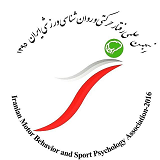Wed, Jul 2, 2025
[Archive]
Volume 2, Issue 3 (8-2020)
IJMCL 2020, 2(3): 13-22 |
Back to browse issues page
Download citation:
BibTeX | RIS | EndNote | Medlars | ProCite | Reference Manager | RefWorks
Send citation to:



BibTeX | RIS | EndNote | Medlars | ProCite | Reference Manager | RefWorks
Send citation to:
Zahiri M, Tahmasebi Boroujeni S. (2020). Improvement in Balance and Gait Speed of MS Patients under Challenge Point Framework. IJMCL. 2(3), 13-22. doi:10.29252/ijmcl.2.3.13
URL: http://ijmcl.com/article-1-83-en.html
URL: http://ijmcl.com/article-1-83-en.html
Ph.D. Student in Motor Control, University of Tehran, Tehran, Iran , m.zahiry@ut.ac.ir
Abstract: (3302 Views)
Background: Challenge Point Framework (CPF) is a model by which it is possible to enhance mobility learning through interference in practice conditions to adjust task difficulty as a consequence of the interaction between skill levels of learner and the task difficulty. As the Multiple Sclerosis (MS) patients have trouble with balance control and walking, giving practice in the framework can help them cope with these movement problems. In the previous studies, it was clear that the method was useful in Parkinson and brain stroke patients, not in MS patients. Therefore, the purpose of this study is to address the CPF to improve control balance and mobility of the MS patients.
Method: We have randomly selected 22 individuals with MS (Mage= 32± 4.5yrs.) and divided them into two groups of control and experiment with 12 interference sessions. We employed Timed Up and Go (TUG) test to evaluate balance and 25-foot walk test to measure speed.
Results: The results have indicated that the speed and balance of the patients in experiment group have been improved due to interference based on CPF (P≥0.001).
Conclusion: Therefore, the efficiency of CPF has been approved in gait speed and balance of the MS patients.
Method: We have randomly selected 22 individuals with MS (Mage= 32± 4.5yrs.) and divided them into two groups of control and experiment with 12 interference sessions. We employed Timed Up and Go (TUG) test to evaluate balance and 25-foot walk test to measure speed.
Results: The results have indicated that the speed and balance of the patients in experiment group have been improved due to interference based on CPF (P≥0.001).
Conclusion: Therefore, the efficiency of CPF has been approved in gait speed and balance of the MS patients.
Type of Study: Original Article |
Subject:
1-3. Sport Psychology
Received: 2020/05/5 | Accepted: 2020/07/20
Received: 2020/05/5 | Accepted: 2020/07/20
References
1. Akizuki, K., & Ohashi, Y. (2013). Changes in practice schedule and functional task difficulty: a study using the probe reaction time technique. Journal of Physical Therapy Science, 25(7), 827-31. http://doi.org/10.1589/jpts.25.827 [DOI:10.1589/jpts.25.827]
2. Bethoux, F., & Bennett, S. (2011). Evaluating walking in patients with multiple sclerosis: which assessment tools are useful in clinical practice? International Journal of MS Care, 13(1), 4-14. http://doi.org/10.7224/1537-2073-13.1.4 [DOI:10.7224/1537-2073-13.1.4]
3. Blair, T. C., Manoharan, M., Rawlings-Rhea, S. D., Tagge, I., Kohama, S. G., Hollister-Smith, J., Wong, S. W. (2016). Immunopathology of Japanese macaque encephalomyelitis is similar to multiple sclerosis. Journal of Neuroimmunology, 291, 1-10. http://doi.org/10.1016/j.jneuroim.2015.11.026 [DOI:10.1016/j.jneuroim.2015.11.026]
4. Dodd, K., Taylor, N. F., Shields, N., Prasad, D., McDonald, E., & Gillon, A. (2011). Strength training can improve muscle performance, quality of life and fatigue in adults with multiple sclerosis: A randomised controlled trial. Physiotherapy (United Kingdom), 97, eS293-eS294. http://doi.org/10.1016/j.physio.2011.04.002 [DOI:10.1016/j.physio.2011.04.002]
5. Ghasemi, M., Gorji, Y., Ashtar, F., & Ghasemi, M. (2015). A study of psychological well-being in people with multiple sclerosis and their primary caregivers. Adv Biomed Res, 4, 49. http://doi.org/10.4103/2277-9175.151545 [DOI:10.4103/2277-9175.151545]
6. Guadagnoli, M. A., & Bertram, C. P. (2014). Optimizing Practice for Performance Under Pressure From the Laboratory. International Journal of Golf Science, 2, 119-127. Retrieved from http://journals.humankinetics.com/doi/abs/10.1123/ijgs.2014-0021 [DOI:10.1123/ijgs.2014-0021]
7. Guadagnoli, M., & Aylsworth, B. (2013). Efficiency in Transfer from the Anchored to Standard Golf Putter. International Journal of Sports. Retrieved from http://journals.sagepub.com/doi/abs/10.1260/1747-9541.8.4.755 [DOI:10.1260/1747-9541.8.4.755]
8. Guadagnoli, M., & Lee, T. (2004). Challenge point: a framework for conceptualizing the effects of various practice conditions in motor learning. Journal of Motor Behavior. Retrieved from http://www.tandfonline.com/doi/abs/10.3200/JMBR.36.2.212-224 [DOI:10.3200/JMBR.36.2.212-224]
9. Guadagnoli, M., & Lindquist, K. (2007). Challenge Point Framework and Efficient Learning of Golf. International Journal of Sports Science and Coaching, 2, 185-197. http://doi.org/10.1260/174795407789705505 [DOI:10.1260/174795407789705505]
10. Hoang, P. D., Cameron, M. H., Gandevia, S. C., & Lord, S. R. (2014). Neuropsychological, balance, and mobility risk factors for falls in people with multiple sclerosis: a prospective cohort study. Archives of Physical Medicine and Rehabilitation, 95(1532-821X (Electronic);-0003-9993 (Linking)), 480. http://doi.org/10.1016/j.apmr.2013.09.017 [DOI:10.1016/j.apmr.2013.09.017]
11. Ilett, P., Lythgo, N., Martin, C., & Brock, K. (2015).Intervention based on the bobath concept on balance and gait in people with multiple sclerosis. Physiotherapy Research, 101, 2015. Retrieved from http://onlinelibrary.wiley.com/doi/10.1002/pri.1624/pdf [DOI:10.1016/j.physio.2015.03.332]
12. Karlsson, A., & Persson, T. (1997). The ankle strategy for postural control--a comparison between a model- based and a marker-based method. Comput.Methods Programs Biomed., 52(3), 165-173. Retrieved from http://www.sciencedirect.com/science/article/pii/S0169260796017944 [DOI:10.1016/S0169-2607(96)01794-4]
13. Krause, D., Brüne, A., Fritz, S., Kramer, P., Meisterjahn, P., Schneider, M., & Sperber, A. (2014). Learning of a Golf Putting Task with Varying Contextual Interference Levels Induced by Feedback Schedule in Novices and Experts. Perceptual and Motor Skills, 118(2), 384-399. http://doi.org/10.2466/23.30.PMS.118k17w3 [DOI:10.2466/23.30.PMS.118k17w3]
14. Lapierre, Y., O'Connor, P., Devonshire, V., Freedman, M. S., Kremenchutzky, M., Yeung, M., & Schecter, R. (2016). Canadian experience with fingolimod: adherence to treatment and monitoring. Canadian Journal of Neurological Sciences/Journal Canadien des Sciences Neurologiques, 43(02), 278-283. [DOI:10.1017/cjn.2015.325]
15. Martino, D., Espay, A., Fasano, A., & Morgante, F. (2016). Abnormalities of Muscle Tone. Disorders of Movement. Retrieved from http://link.springer.com/chapter/10.1007/978-3-662-48468-5_2 [DOI:10.1007/978-3-662-48468-5_2]
16. Motl, R. W., Smith, D. C., Elliott, J., Weikert, M., Dlugonski, D., & Sosnoff, J. J. (2012). in Persons With Significant Disability From Multiple Sclerosis : A Pilot Study. Journal of Neurologic, 36(March), 32-37. http://doi.org/10.1097/NPT.0b013e3182477c92 [DOI:10.1097/NPT.0b013e3182477c92]
17. Onla-or, S., & Winstein, C. J. (2007). Determining the Optimal Challenge Point for Motor Skill Learning in Adults With Moderately Severe Parkinson's Disease. Neurorehabilitation and Neural Repair, 22(4), 385-395. http://doi.org/10.1177/1545968307313508 [DOI:10.1177/1545968307313508]
18. Peruzzi, A., Cereatti, A., Croce, U. Della, & Mirelman, A. (2016). Effects of a virtual reality and treadmill training on gait of subjects with multiple sclerosis: A pilot study. Multiple Sclerosis and Related Disorders, 5, 91-96. http://doi.org/10.1016/j.msard.2015.11.002 [DOI:10.1016/j.msard.2015.11.002]
19. Pollock, C. L., Boyd, L. A., Hunt, M. A., & Garland, S. J. (2014). Use of the challenge point framework to guide motor learning of stepping reactions for improved balance control in people with stroke: a case series. Physical Therapy, 94(4), 562-70. http://doi.org/10.2522/ptj.20130046 [DOI:10.2522/ptj.20130046]
20. Sebastia, E., Sandroff, B. M., Learmonth, Y. C., & Motl, R. W. (2016). Validity of the Timed Up and Go Test as a Measure of Functional Mobility in Persons With Multiple Sclerosis. Archives of Physical, 1072-1077. http://doi.org/10.1016/j.apmr.2015.12.031 [DOI:10.1016/j.apmr.2015.12.031]
21. Verma, J. P. (2011). Statistical Methods for Sports and Physical Education. Retrieved from https://scholar.google.com/scholar?q=Statistical+methods+for+sports+and+physical+education&btnG=&hl=en&as_sdt=0%2C5
22. Yim-Chiplis, P. K., & Talbot, L. a. (2000). Defining and measuring balance in adults. Biological Research for Nursing, 1, 321-331. http://doi.org/10.1177/109980040000100408 [DOI:10.1177/109980040000100408]
23. Zampieri, C., & Di Fabio, R. P. (2008). Balance and eye movement training to improve gait in people with progressive supranuclear palsy: quasi-randomized clinical trial. Physical Therapy, 88(12), 1460-73. http://doi.org/10.2522/ptj.20070302. [DOI:10.2522/ptj.20070302]
Send email to the article author
| Rights and Permissions | |
 |
This work is licensed under Attribution 4.0 International (CC BY 4.0). |












